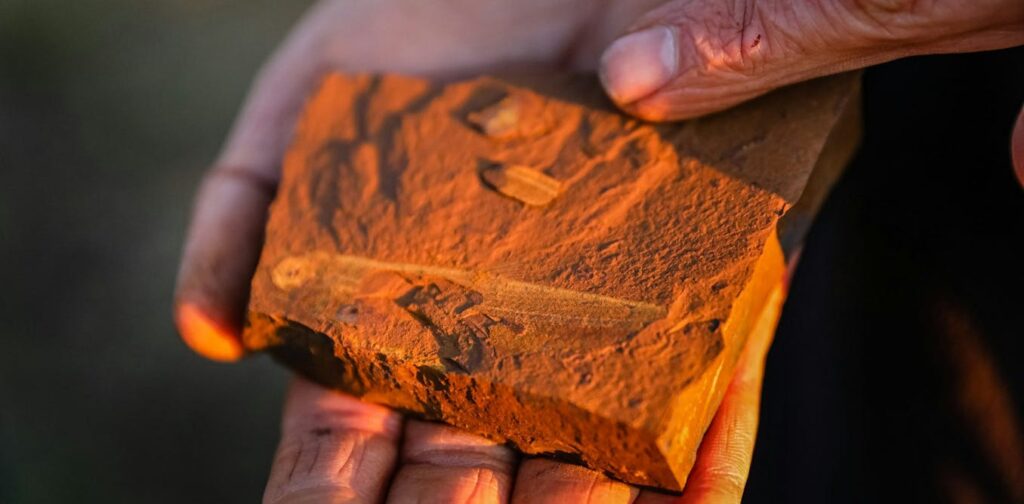
Hidden beneath the rolling farmland of the central tablelands in New South Wales, Australia, lies an extraordinary fossil site known as McGraths Flat. Dating back between 11 million and 16 million years to the Miocene epoch, this site is rewriting the rules on exceptional fossil preservation. It was during this period that many of today’s familiar plants and animals evolved. The discovery, led by paleontologists and geologists from the Australian Museum Research Institute, has unearthed fossils that reveal an ancient rainforest ecosystem where dust and drought now prevail.
The sedimentary rocks at McGraths Flat are strikingly red, composed entirely of goethite, a fine-grained mineral rich in iron. This mineral composition has preserved a diverse array of plants, insects, spiders, fish, and feathers with remarkable detail. A recent study published in the journal Gondwana Research highlights how these rocks challenge traditional ideas about where well-preserved fossil sites can be found and why.
Beyond Shale and Sandstone
Traditionally, the most exceptionally well-preserved fossil sites have been found in rocks dominated by shale, sandstone, limestone, or volcanic ash. Sites like Germany’s Messel Pit and Canada’s Burgess Shale are renowned for their rapid burial of organisms in fine-grained sediments, allowing for the preservation of soft tissues as well as hard parts.
Messel Pit has preserved fossils approximately 47 million years old, showing outlines of feathers, fur, and skin. The Burgess Shale contains soft tissues from some of Earth’s earliest animal life, dating back about 500 million years.
In contrast, sedimentary rocks composed entirely of iron, like those at McGraths Flat, are unexpected hosts for well-preserved terrestrial fossils. Traditionally, iron-rich sedimentary rocks are associated with banded iron formations, massive deposits formed around 2.5 billion years ago in Earth’s ancient, oxygen-depleted oceans, long before complex life evolved.
In more recent geological history, iron is typically seen as a weathering product, forming rust on continents exposed to an oxygen-rich atmosphere. Australia’s iconic red-rocked outback, for instance, features these ancient weathered landscapes. Yet, McGraths Flat defies these expectations.
Terrestrial Life Entombed in Iron
McGraths Flat is composed of a very fine-grained, iron-rich rock known as ferricrete, essentially a cement made from iron. The ferricrete consists almost entirely of microscopic iron-oxyhydroxide mineral particles, each just 0.005 millimeters across. When organisms died and were buried in this sediment, the minute scale of these particles allowed them to fill every cell, resulting in extraordinarily well-preserved soft tissue fossils.
Fossil sites preserving terrestrial life are notoriously rare, and those preserving soft tissues are even rarer. The exceptional detail captured in the McGraths Flat fossils provides new insights into past life, revealing individual pigment cells in fish eyes, internal organs of insects and fish, and even delicate spider hairs and nerve cells.
This level of preservation rivals other well-preserved fossil sites, such as those consisting of shale or sandstone. However, here they are entombed in iron.
How Did McGraths Flat Form?
The study offers new insights into the formation of this unique fossil site, a crucial step for identifying similar terrestrial fossil troves in iron-rich environments. McGraths Flat began forming during the Miocene when iron leached from weathering basalt under warm, wet rainforest conditions. Acidic groundwater carried the dissolved iron underground until it reached a river system with an oxbow lake—an abandoned river channel. There, the iron formed ultra-fine iron-oxyhydroxide sediment that rapidly coated dead organisms on the lake floor, replicating their soft tissue structures down to the cellular level.
A New Fossil Roadmap
Understanding how McGraths Flat formed could provide a roadmap for discovering similar iron-rich fossil sites worldwide. Key features to look for include very fine-grained and finely layered ferricrete in regions where ancient river channels cut through older iron-rich landscapes, such as basaltic rocks from volcanoes. Additionally, areas that experienced ancient warm, humid conditions promoting intense weathering, and where the surrounding geology lacks significant limestone or sulfur-containing minerals, are promising candidates.
The red rocks of McGraths Flat open a new chapter in our understanding of how exceptionally well-preserved fossil sites can form. The next breakthrough in understanding ancient terrestrial life might not emerge from traditional shale or sandstone fossil beds but from rusty-red rocks hidden beneath our feet.
The study’s authors acknowledge the traditional custodians of the land and waterways on which McGraths Flat is located, the Wiradjuri Nation people.





